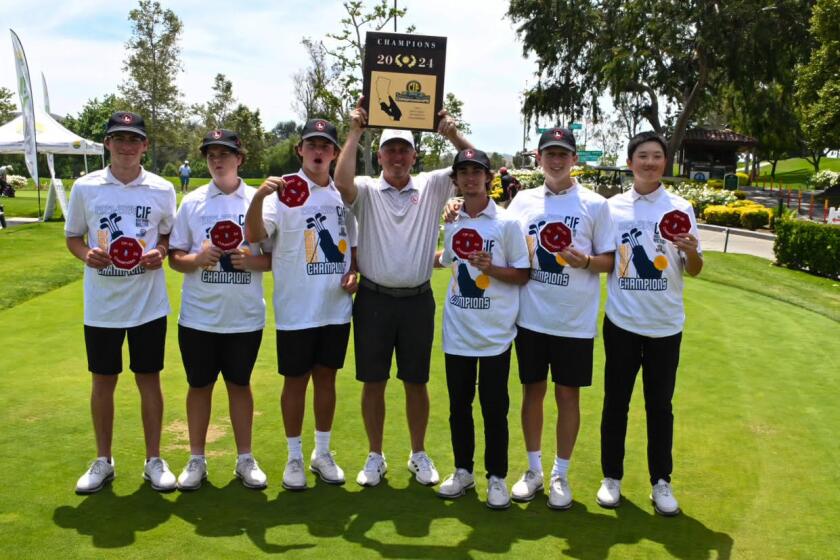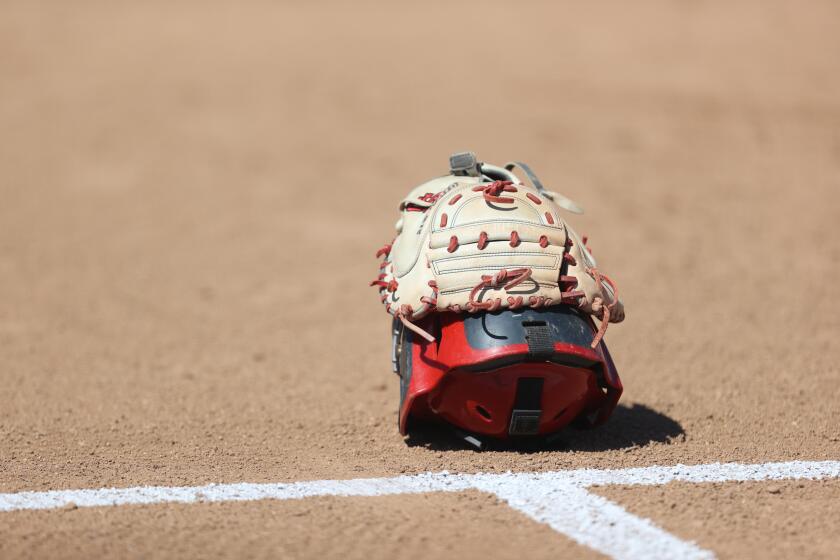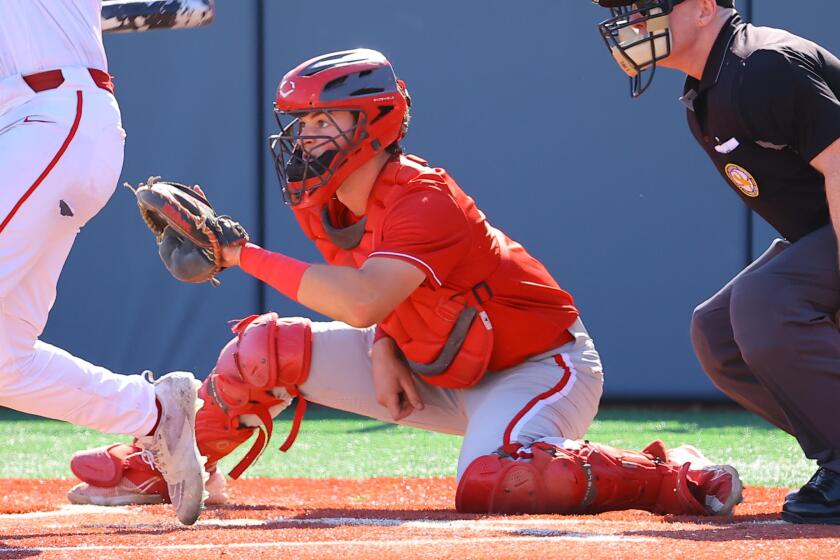BELEAGUERED LEAGUE : Garden Grove Coaches Upset About Disadvantages Dictated by District
It’s called an athletic period. It’s a loosely structured hour that allows a coach to train athletes during the off-season.
The class starts at 1:30 p.m. at most schools, and it gives coaches a chance to offer individual instruction, to provide off-season conditioning or simply to get acquainted with team members.
For the record:
12:00 a.m. April 21, 1988 For the Record
Los Angeles Times Thursday April 21, 1988 Orange County Edition Sports Part 3 Page 13 Column 1 Sports Desk 2 inches; 56 words Type of Material: Correction
Los Amigos High School Athletic Director Dave Auxier was incorrectly quoted in Wednesday’s Times as saying that he thinks the Garden Grove Unified School District would not introduce a coaches’ athletic period to district high schools until four or five years had passed. Auxier actually said it would take four or five years before he could replace walk-on coaches with full-time teacher-coaches.
The class is practically taken for granted throughout Orange County. But for seven Garden Grove Unified School District high schools--Bolsa Grande, Garden Grove, La Quinta, Los Amigos, Pacifica, Rancho Alamitos and Santiago--the period doesn’t exist.
There hasn’t been an athletic period in the district for 20 years. That’s because of declining enrollment among the district’s schools, budget cutbacks and the lack of funds to hire coaches with teaching credentials to oversee the classes, as required by state law.
But district administrators and school principals are working on a plan to introduce a limited athletic period that they hope will begin in the fall.
The proposed period will be contingent on the availability of facilities and staff coaches, as walk-on coaches are not allowed to teach the class. Also, arrangements must be made for student-athletes who are enrolled in academic classes that are offered only during the sixth period.
“We need something to be competitive with other leagues,” said Ken Calkins, district assistant superintendent. “But we have to make sure the plans are done right. Hopefully, we will have a plan approved within a month, since we’re already working on master schedules for next year.”
But Dave Auxier, athletic director at Los Amigos, doubts whether the athletic period will be introduced next school year.
“Everyone’s general feeling, it seems, is that maybe the school district isn’t really behind us,” he said. “Maybe they’re starting to listen a little more. I think it (the athletic period) could happen, but not until the next four or five years.”
The frustrations over the lack of a sixth-period physical education period have been brewing for some time. Coaches believe the situation has had a direct result in:
--The league’s recent lack of success in the Southern Section playoffs.
--The fact that since 1980, a total of 37 coaches in the sports of football, basketball and baseball have left the league. By contrast, the Sunset League has had 15 coaching changes in the same period.
--The fact that athletes in the Garden Grove league often are not as well-conditioned as their opponents early in the season.
The coaches’ frustrations boiled over this year when Kennedy, a member of the Anaheim Union High School District and a new addition to the Garden Grove League, continued to schedule an athletic period. Kennedy is not under the jurisdiction of Garden Grove district officials, who make up class schedules.
“Kids in this district are being cheated,” said Vern Nelson, baseball coach at Bolsa Grande since 1976. “I feel I’m limited in what I can teach a kid. If I had a son who was a baseball prospect, I wouldn’t let him play in this league.”
Jim Perry, athletic director and basketball coach at La Quinta, said it often takes six weeks for his basketball teams to catch up to other teams that have the benefit of the athletic period.
“We’re fighting for our lives,” he said. “We’re just so far behind everybody else. The CIF (Southern Section) keeps shortening our practice days, and we don’t have an athletic period.
“We play and practice until the middle of January before we get caught up to everyone else. In some cases, we never do.”
Paula Cervantes, the fifth-year girls’ volleyball and softball coach at Garden Grove, has previously coached in the Tustin and Santa Ana school districts. She sympathizes with the district’s problem of declining enrollment and tighter budgets but cites other districts’ ability to maintain the athletic period in an era of cutbacks.
“Other districts have come up with a solvable solution. Why can’t we?” Cervantes said. “I get so frustrated. I give 150% to coaching, but sometimes I feel my administration is fighting me more than helping me.”
Coaches predicted that Kennedy would dominate play in its first year in the league. Kennedy responded by winning the league varsity basketball title and is in second place in baseball. Its football team, which was 0-10 the season before, finished 2-7-1.
Kennedy’s spring coaches have an advantage, following a Southern Section rule that states: “Between the last interscholastic contest of a school and May 23, coaches may associate with potential team members for the purpose of learning or practicing skills of their sport during one regular physical education class.”
Coaches of winter sports teams at Kennedy are allowed to associate with their team members before Nov. 9 and until May 23 in a physical education class. Football players are generally not affected by the lack of an athletic period because a coach has three days of conditioning and two weeks of practice before the first game.
Dave Demarest, the highly successful baseball coach at La Quinta, said he has problems evaluating players with so little preparation time.
“Let’s say I have a kid on the frosh-soph team who has some varsity potential, but I don’t include him on the varsity team for the summer,” he said. “Once school begins, I can’t try out the player, I can’t cut the player, I can’t coach the player and I can’t evaluate the player until Feb. 22.”
Baseball coaches had only six days to prepare their players for their first scrimmage. Nelson, a varsity coach at Bolsa Grande since 1976, sometimes fears for his players’ welfare with so little preparation time.
“We continually have problems with kids who get sore arms,” Nelson said. “I’ve got a couple of kids who have been complaining of sore arms all season.”
Tony Lipold was the varsity basketball coach at Bolsa Grande for nine years before he resigned after the 1986-87 season. He is currently the activities director at Edison High in Huntington Beach.
Lipold, now an administrator, understands the merit of education and academics. But he never understood the reasoning that an athletic period would sacrifice academics for athletics.
“Was it asking too much for an hour a day to have your athletes? I don’t think so,” he said. “I coached for enjoyment. But there was nothing pleasant or relaxing when you’re coaching without an athletic period.
“I always felt the basketball teams in our league were under a big disadvantage without the athletic period. We went to the playoffs five times, but we had to work twice as hard as everyone else to get there.”
Dick Katz posted a 61-19 record from 1978 to 1981 as basketball coach at La Quinta, but he said coaching was a hassle without the athletic period. Katz currently coaches at Westminster in the Huntington Beach district.
“Dave Demarest and I went to the district office in 1980 and asked why our league didn’t have an athletic period,” Katz said. “We were told by (then assistant superintendent) Frank Starnes that if an athletic period was adopted, coaches would get carried away.
“His rationale was that the lack of the period was fair for everybody in the league since it was a district league. I said ‘Fine, but what about competing in the playoffs?’ I got the feeling athletics wasn’t important.
“We won because we had great kids who put the time in away from the gym. Johnny Rogers would come in at 5:30 in the morning and lift weights. Funny, but everybody thought I was cheating when we won without the athletic period.”
Lee Lanan, softball and tennis coach at Los Amigos for nine years and now Cervantes’ assistant at Garden Grove, coached for five seasons before she discovered that her district was the only one operating without an athletic period.
“I never knew other schools had the athletic period until my daughter started coming home from tennis practice (at Westminster) at 4:15,” she said. “I’d ask her how she finished so early every day, and she said, ‘Mom, we start at 1:30.’ ”
Get our high school sports newsletter
Prep Rally is devoted to the SoCal high school sports experience, bringing you scores, stories and a behind-the-scenes look at what makes prep sports so popular.
You may occasionally receive promotional content from the Los Angeles Times.



